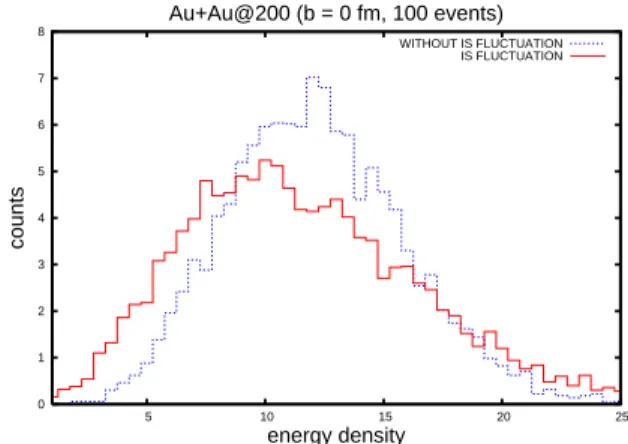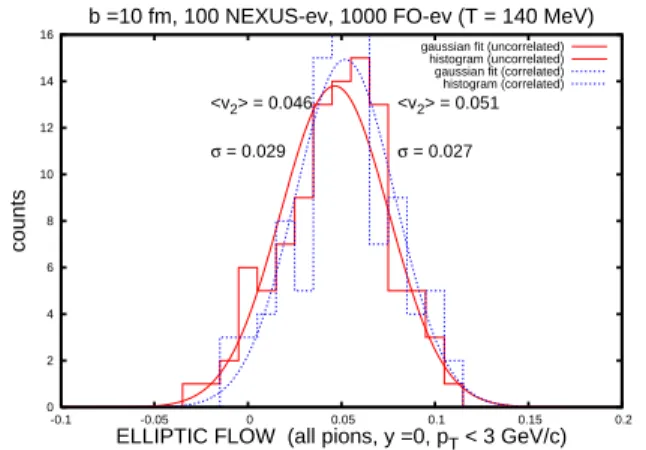Brazilian Journal of Physics, vol. 37, no. 1, March, 2007 41
Effects of Nucleus Initialization on Event-by-Event Observables
B. Mattos Tavaresa, H.-J. Drescherb, and T. Kodamaa
aInstituto de F´ısica, Universidade Federal do Rio de Janeiro, 68528, 21945-970, Rio de Janeiro, RJ, Brasil b Frankfurt Institute for Advanced Studies (FIAS), Johann Wolfgang Goethe-Universi ¨at,
Max-von-Laue-Str. 1, 60438 Frankfurt am Main, Germany
Received on 29 September, 2006
In this work we present a study of the influence of nucleus initializations on the event-by-event elliptic flow coefficient,v2. In most Monte-Carlo models, the initial positions of the nucleons in a nucleus are completely
uncorrelated, which can lead to very high density regions. In a simple, yet more realistic model where overlap-ping of the nucleons is avoided, fluctuations in the initial conditions are reduced. However,v2distributions are
not very sensitive to the initialization choice.
Keywords: Elliptic flow; Fluctuations in the initial conditions; Hydrodynamics
I. INTRODUCTION
The main goal of studying ultra-relativistic heavy ion reac-tions is to identify (or not) the formation of the Quark-Gluon Plasma (QGP). Event-by-event (EbyE) analysis of global ob-servables can significantly contribute in this direction [1]. One way to measure EbyE fluctuations is the statistical approach: each observable in an event should contain fluctuations and the distribution of such an observable can be characterized by its mean value and higher moments [2].
The most interesting fluctuations are dynamical, since they give important information about the formation of the system. Possible examples are the occurrence of jets, giving rise to fluctuations in the highpttail of transverse momentum
distri-butions, and the fluctuation in the anisotropic flow coefficient v2due to unusual hard/soft equation of state or fluctuating ini-tial conditions [1, 3].
Other sources of fluctuations of statistical or technical na-ture can also be present in EbyE distributions. For example, finite multiplicity affects the determination ofhpti, ratios of multiplicities of particle species and also the strength of the anisotropic flow coefficient, due to imprecise determination of event plane [1]. In this work, we are interested in a technical source of fluctuations, commonly present in event generators, the initialization of the positions of the nucleons in a nucleus before the collision.
II. HYDRODYNAMICAL MODEL
We have proposed that dynamical and technical sources of fluctuations can be studied in the framework of relativis-tic hydrodynamics, which allows one to separate the relevant physics from statistical noise [4]. If the local thermal equilib-rium is attained in relativistic heavy ion collisions, hydrody-namical description may be most adequate for the space-time evolution of the system. Once the initial conditions (spatial configuration of 4-velocity field and conserved currents) of the system are specified, the principal factor which charac-terizes the hydrodynamical motion is the equation of state of the matter. When the hydrodynamical prescription is not valid anymore, one must employ a decoupling criterion to generate
particles, i.e, hadrons. So we have only three inputs in the hy-drodynamical approach: initial conditions, equation of state and the decoupling criterion.
In this work, we employ the numerical code SPHERIO [5], which solves the hydrodynamical equations of motion in 3 dimensions and can deal with any kind of spatial configura-tion in the initial condiconfigura-tions. For the equaconfigura-tion of state, we have adopted a quark-gluon free gas with a bag constant of 380 MeV/fm3 for the QGP phase, and a hadron resonance gas with excluded volume (only for baryons) in the confined phase. Almost all the resonances up to 2.5 GeV have been used. The phase boundary is obtained via the Gibbs criterion, and the transition is first order for every chemical potential. As a decoupling criterion, we adopted Cooper-Frye procedure [6] with a fixed freeze-out temperature of 140 MeV. For fur-ther details in the equation of state and decoupling prescrip-tion used, see [7].
III. NUCLEUS INITIALIZATION: CORRELATED VERSUS UNCORRELATED NUCLEON POSITIONS.
For the initial condition, we use the NEXUS event gen-erator [9]. Based on the Gribov-Regge model of hadronic collisions, it generates a spatial distribution of the energy-momentum tensor Tµν and the baryon number density n
B
on the hyper-surfaceτ=const. Monte-Carlo generation of events from this model give rise to physical fluctuations in the initial conditions. However, the procedure chosen to initialize the nuclei before the collision, may generate also unphysical fluctuations, which can influence EbyE observables.
Usually one employs the Wood-Saxon distribution
ρ(r) =ρ0
1
1+exp[(r−R)/D], (1) to determine the initial position of theA nucleons within a nucleus. The constants in eq. (1) are the nuclear densityρ0= 0.16 fm−3, the nucleus radiusRand the diffuseness parameter D∼0.55 fm (usually).
un-42 B. Mattos Tavares et al.
physical. However, this method is used in many Monte-Carlo codes, since it is widely believed that unphysical fluctuations average out, at least for inclusive spectra. Some models, e.g HIJING [8] are aware of this problem, and employ a rejection technique for nucleons which are closer to each other than a given distance. However, for realistic distances (in the order of 2 times the proton radius∼1.6 fm) this leads to a pushing of nucleon positions towards the shell and lowers density in the center. Nexus generates nuclei, with completely uncore-lated positions.
The most suitable initialization of a nucleus would be a se-lection of nucleon positions according to a realistic wave func-tion which includes correlafunc-tions [10]. Each nucleon would be surrounded by a corelation hole [10], which prevents other nucleons from occupying the same space. For simplicity, we employ a lattice model in order to demonstrate the effect. The nucleons are placed on a body-centered cubic lattice (BCC) and the positions are then accepted with a probability ρ/ρ0 given by eq. (1). The packing efficiency of a BCC lat-tice is e=8/3∗π/(4/√3)3=0.68 and the lattice spacing isl= (e/ρ0/π∗3/4)1/3∗4/
√
3=2.32 fm [11]. This method correctly reproduces the density in the center of the nucleus, as can be seen in Fig. 1. To avoid lattice artifacts, each nu-cleus is rotated by some random angles. We shall call this method lattice (or correlated) initialization.
0 5 10 15 20 25 30 35 40 45 50
0 0.05 0.1 0.15 0.2 0.25 0.3 0.35 0.4 0.45
counts
density [fm-3] uncorrelated
lattice type
FIG. 1: Distribution of the nucleon density in the center of the nu-cleus (r<4 fm), for correlated (dashed line) and uncorrelated (solid line) nucleons.
In Fig. 2 we show a plot for the energy density distribution for the correlated (dashed line) and the uncorrelated (full line) cases. Each distribution represents 100 NEXUS events for Gold-Gold collisions with √s=200 GeV per nucleon pair, with zero impact parameter b (central collisions). One can easily check that the energy density from correlated nucleons is narrower than the uncorrelated case, as expected. It can also be seen that the average energy density is a larger for the lattice type initialization.
0 1 2 3 4 5 6 7 8
5 10 15 20 25
counts
energy density Au+Au@200 (b = 0 fm, 100 events)
WITHOUT IS FLUCTUATION IS FLUCTUATION
FIG. 2: Energy density distribution for central collisions (b = 0).
0 5 10 15 20 25 30 35
-0.1 -0.05 0 0.05 0.1
counts
ELLIPTIC FLOW (all pions, y =0, pT < 3 GeV/c) b =2fm, 100 NEXUS-ev, 1000 FO-ev (T = 140 MeV)
<v2> = 0.008 σ = 0.014 <v2> = 0.005
σ = 0.013
gaussian fit (uncorrelated) histogram (uncorrelated) gaussian fit (correlated) histogram (correlated)
FIG. 3: Elliptic flow distributions for central collisions (b= 2 fm).
0 5 10 15 20
-0.1 -0.05 0 0.05 0.1 0.15 0.2
counts
ELLIPTIC FLOW (all pions, y =0, pT < 3 GeV/c) b =7 fm, 100 NEXUS-ev, 1000 FO-ev (T = 140 MeV)
<v2> = 0.041
σ = 0.019 <v2> = 0.043
σ = 0.019
gaussian fit (uncorrelated) histogram (uncorrelated) gaussian fit (correlated) histogram (correlated)
FIG. 4: Elliptic flow distributions for mid-central collisions (b= 7 fm).
IV. RESULTS
In Figs. 3, 4 and 5 we show EbyE distributions for the ellip-tic flow coefficientv2(integrated overpt) of pions, computed
Brazilian Journal of Physics, vol. 37, no. 1, March, 2007 43
0 2 4 6 8 10 12 14 16
-0.1 -0.05 0 0.05 0.1 0.15 0.2
counts
ELLIPTIC FLOW (all pions, y =0, pT < 3 GeV/c) b =10 fm, 100 NEXUS-ev, 1000 FO-ev (T = 140 MeV)
<v2> = 0.046
σ = 0.029
<v2> = 0.051
σ = 0.027
gaussian fit (uncorrelated) histogram (uncorrelated) gaussian fit (correlated) histogram (correlated)
FIG. 5: Elliptic flow distributions for peripheral collisions (b= 10 fm).
10 fm (peripheral collisions), at mid-rapidity, for Gold-Gold reactions at √s=200 GeV per nucleon pair. We show the histograms and the Gaussian fits for the observable originated from the correlated (dashed) and uncorrelated (solid) nucleus initialization. We computed 100 events per type of
initializa-tion at each impact parameter. Despite the differences in the energy density distributions, the v2 in all centralities shows very similar variancesσ. That may be caused by the hydro-dynamical expansion which reduces the effects of the fluctua-tions.
V. CONCLUSIONS AND PERSPECTIVES
In this work we studied the effects of nucleus initialization on EbyE observables. Thev2parameter is not very sensitive to the choice of nucleus initialization. The influence on other observables are in progress. We also plan to study the effects of impact parameter distribution, reaction plane determination (for thev2case) and other finite multiplicity related observ-ables. The goal is to develop a method that separates physical from statistical fluctuations.
Acknowledgments
the authors would like to thanks for discussions with A. Du-mitru. This work has been done with the support of FAPESP, CNPq, DAAD and CAPES.
[1] S. Voloshin, V. Koch, and H. G. Ritter, Phys. Rev. C 60, 0224901 (1999).
[2] See for example S. Jeon, V. Koch, Phys. Rev. Lett.85, 2076 (2000).
[3] Y. Hama, T. Kodama, and O. Socolowski, Braz. J. Phys.35, 24 (2005).
[4] B. Mattos Tavares, PhD thesis.
[5] for SPH procedure in RHIC see C. E. Aguiar, et alJ. of Phys. G27, 75 (2001).
[6] F. Cooper, G. Frye, Phys. Rev. D10, 186 (1974); F. Cooper, G. Frye, and E. Schonberg, Phys, Rev. D11, 192 (1975).
[7] C. E. Aguiar, Y. Hama T. Kodama, and T. Osada, Nucl. Phys.
A698, 639c (2002); C. E. Aguiar, Y. Hama, T. Kodama, and T. Osada,inNew States of hadronic interactions — PASI 2002, AIP Conference Proceedings,631, 686 (2002).
[8] M. Gyulassy, X.-N. Wang Comp. Phys. Comm. 83, 307 (1994).
[9] H.J. Drescheret al, Phys. Rev. C65, 054902 (2002).
[10] G. Baym, B. Bl¨atel, L. L. Frankfurt, H. Heiselberg, and M. Strikman Phys. Rev. C52, 1604 (1995). C. K. Wong, Phys. Rev. C35, 545 (1987).

